The common pomegranate houseplant combines decorative appeal, fruit-bearing qualities, and low maintenance. To grow a pomegranate tree at home, it's essential to understand its care and propagation specifics. This article also includes descriptions of dwarf pomegranate varieties.
Table of contents
Dwarf Pomegranate and Its Varieties
Dwarf pomegranates are bred for indoor cultivation as decorative and fruit-bearing trees. Numerous varieties of this plant exist—here are the most popular ones.
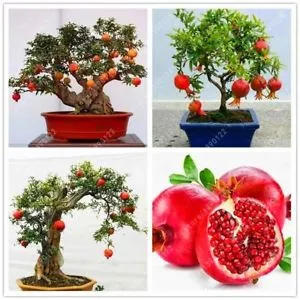
Nana
This tree grows up to 1 m tall. Its leaves are small and oval-shaped, while the flowers are crimson. The fruits measure 3-5 cm. The pomegranate begins flowering in its second year.
Alba
This variety can grow up to 3 m but is often pruned to maintain a compact shape. Its leaves are dark green, glossy, and slightly elongated. Flowering begins in the second year, producing large white or creamy double flowers up to 6 cm in size. This is a decorative variety and does not bear fruit.
Baby
A miniature plant requiring manual pollination, it reaches up to 50 cm in height. Its small, elongated leaves grow evenly along the branches. Flowering starts in the 3rd or 4th year, with terracotta or red flowers appearing singly or in clusters of 5-7. The fruits are brownish-yellow and measure around 3 cm.
Carthage
This variety grows up to 80 cm tall. Flowering begins 6-8 years after seed planting. The red flowers are about 4 cm in size, while the fruits reach up to 6 cm.
Ruby
This tree grows to about 70 cm tall. Its flowers are a deep ruby red, and the fruits reach 6-8 cm in size, weighing up to 100 g.
What the Plant Looks Like
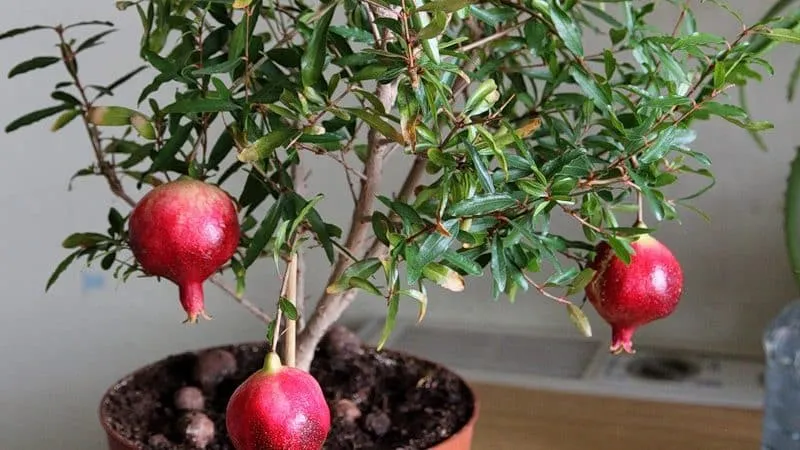
The dwarf pomegranate is a compact plant, reaching up to 1 m in height. It can be shaped into a unique 25-30 cm bonsai. Its leaves are green, glossy, and elongated, while the flowers come in burgundy shades.
Key Characteristics:
- First flowering occurs 3-4 months after planting.
- Early fruiting—a two-year-old plant can produce up to a dozen 3-5 cm pomegranates. The fruits are edible.
- Retains leaves in winter.
- Low-maintenance.
How to Grow a Pomegranate Tree at Home
Indoors, pomegranates can be grown from seeds or propagated via cuttings and grafting.
Growing from Seeds (Self-Harvested)
Advantage: High decorative appeal.
Disadvantage: No fruiting.
The best time to plant seeds is late February to early March. The ideal seeds come from a ripe, healthy fruit—such as a fully matured indoor pomegranate. Extracted seeds should be cleaned of pulp.
Note: If pulp remains, it may rot and kill the sprout.
Suitable seeds are cream-colored and firm to the touch. A universal potting mix or citrus-specific soil works well as a substrate.
How to grow a pomegranate from seeds:
- Plant seeds 1-1.5 cm deep in soil.
- Water after planting, cover with glass or plastic, and place in a sunny spot.
- Care includes ventilation and misting.
- Once true leaves appear, transplant seedlings into individual pots, trimming the root by a third.
From Store-Bought Seeds
When buying pomegranate seeds, check the expiration date—fresher seeds have better germination rates (65-95%).
Preparation involves treating seeds with a growth stimulant like Biobizz Root Juice.
Steps to grow a pomegranate tree from seeds:
- Plant seeds 0.5-1 cm deep in moist soil, spaced 4 cm apart.
- Cover the container with plastic and ventilate regularly.
- Mist seedlings daily.
- First sprouts appear in 14-20 days.
- Transplant into individual pots after 3-4 months, when 4-5 true leaves develop.
Flowering and fruiting begin 5-8 years after planting.
Note: Seed-grown plants rarely inherit all parent traits. For a guaranteed beautiful and fruit-bearing pomegranate, propagate via cuttings.
Propagation via Cuttings
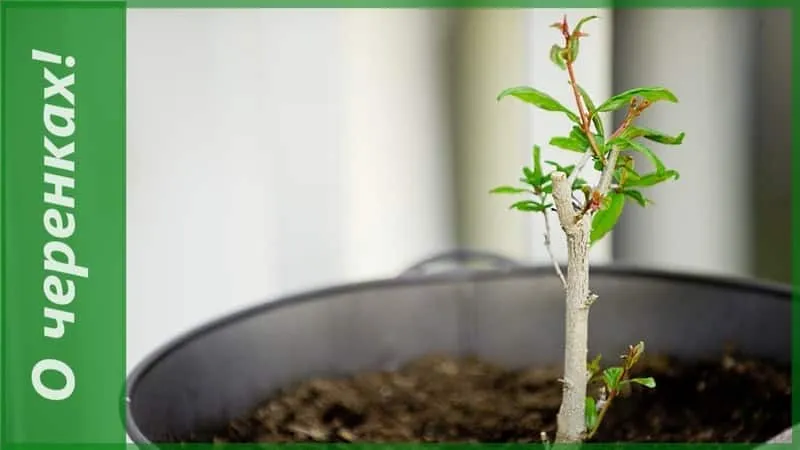
Advantages:
- Retains parent plant traits—disease resistance, flowering, and fruiting ability.
- Flowers in the second year.
Disadvantage: Cuttings root slowly, and not all survive—use multiple cuttings for better success.
Summer pruning and propagation often coincide since cuttings root better in warm months. Use semi-hardwood cuttings (10-15 cm long with 5-7 developed buds).
Propagation steps:
- Make a diagonal cut on the cutting and treat with a rooting hormone (Clonex Gel).
- Plant cuttings 3 cm deep in moist soil at a 45° angle, spaced 10 cm apart.
- Cover with a plastic bottle and place in a warm, bright spot.
- Care includes ventilation and misting—keep soil moist.
- Rooting takes up to two months.
- Transplant into individual pots once new leaves appear.
Grafting
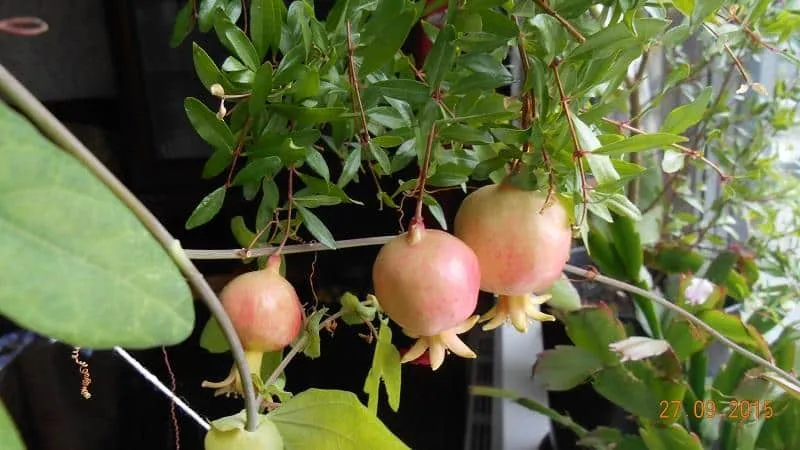
Another propagation method. Graft in spring. Requirements:
- Rootstock – a seedling grown from seed.
- Scion – a cutting from a fruit-bearing plant.
Grafting methods:
- Simple Whip Graft. Perform in the tree’s second year. Use a 5 cm cutting with four buds. Rootstock and scion should match in thickness—make 3 cm diagonal cuts, join tightly, seal with grafting wax, and secure with tape until fused.
- Side-Veneer Graft. Here, the scion is thinner. Make a side cut in the rootstock, insert the wedge-cut scion, and secure with tape.
- Cleft Graft. Use scion and rootstock of equal thickness. Trim the rootstock to 30 cm, split the center, insert the wedge-cut scion, seal with wax, and wrap with tape.
Flowering occurs 3-4 years after grafting.
Flowering and Fruiting of Indoor Varieties
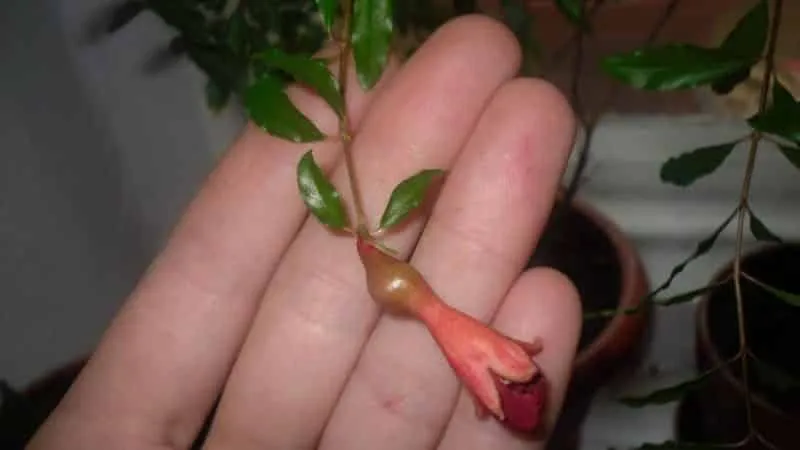
Indoor pomegranates start flowering at least three years after planting, depending on propagation method. Buds, ovaries, and fruits may coexist.
Flowering is long-lasting (mid-spring to late summer), abundant, and striking, featuring large orange-red blooms. Flower types:
- Bell-shaped (male) – Non-fruiting. Most flowers are this type, appearing in large numbers from the second year. They bloom briefly (2-3 days) before falling.
- Vase-shaped (female) – Fruit-bearing. These bloom for up to 10 days, later forming small, round, brown-red fruits with edible seeds.
In the first year, remove all ovaries; in the second, leave 2-3 fruits to avoid exhausting the plant.
Care Tips for Decorative Pomegranates Indoors
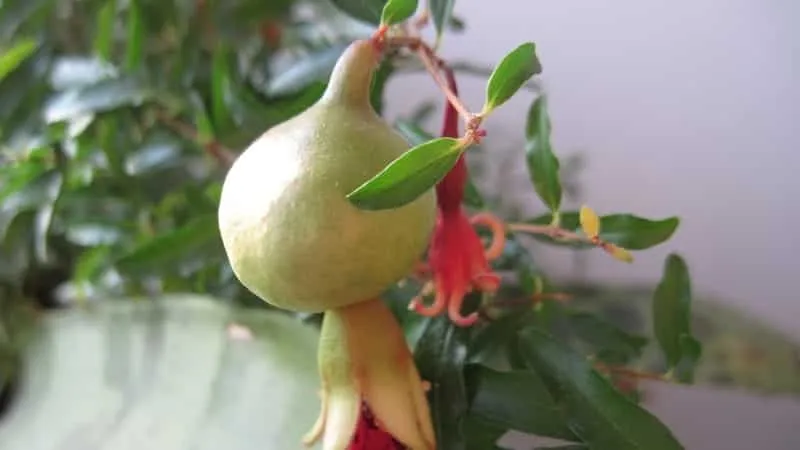
Pomegranates are low-maintenance but need specific conditions to thrive.
Repotting
Repot in late February or early March. Handle roots carefully—if damaged, trim and treat with charcoal.
Young plants need annual repotting; those over three years old—every four years or when root-bound. Each new pot should be 2 cm wider.
Note: Large, mature trees aren’t repotted—just replace the top 5 cm of soil.
Choosing the Right Pot
Pot size depends on the tree’s height and age. Start with a 100 ml pot.
Tip: A snug pot reduces sterile flower formation.
Mature plants need 500 ml+ pots matching their root size.
Lighting
Pomegranates love bright sun. Place them in well-lit spots. In spring and summer, move outdoors with partial shade. Return indoors before frost.
Humidity
Moderate humidity (~65%) is ideal. For dry air, mist leaves or place a water tray nearby. High humidity requires ventilation.
Temperature
Summer ideal: +18…+25°C outdoors. Winter: +10…+12°C indoors. Move outside after frost.
Soil
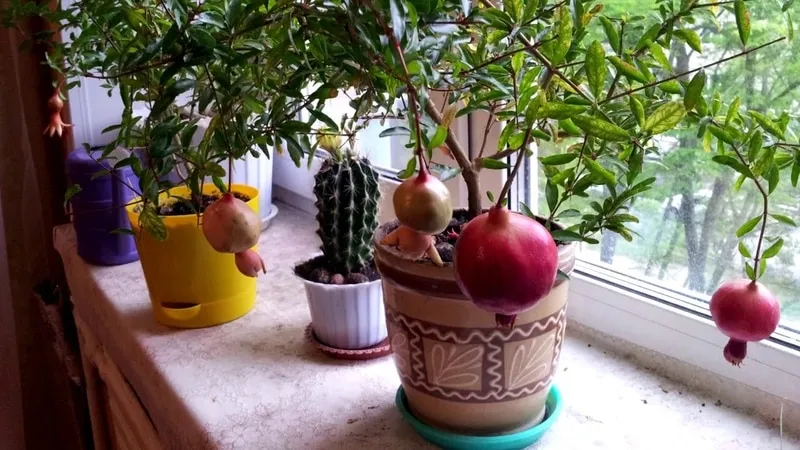
Pomegranates aren’t picky—use nutrient-rich, well-draining soil. A mix of turf, leaf, sand, and peat (2:1:1:1) works well.
Watering
During active growth, water every 3-4 days. When fruiting, keep soil moist to prevent cracked ovaries.
In dormancy, water every two weeks—don’t let soil dry completely. Maintain moisture via misting or loosening.
Water at the base, avoiding leaves—roots are shallow.
Fertilizing
Feed every two weeks in spring-summer with liquid houseplant fertilizer (e.g., Biobizz Grow). Also use potassium-phosphorus and nitrogen supplements (BioBizz Bio-Heaven).
For fruiting, use organic options:
- Diluted chicken manure (1:2, ferment 15-20 days, then dilute 1:25 before use).
- Compost tea (1:10).
- Wood ash solution (1:10).
Stop fertilizing in autumn.
Misting
Mist only in dry heat (+28°C+) or direct sun. Not needed in winter with normal humidity.
Pruning and Shaping
Prune before the growing season (February). Remove dead flowers and leaves regularly.
Pruning conserves energy for flowering/fruiting, rejuvenates, and encourages branching.
Shape by pinching, trimming, or bending branches with wire. For a spherical crown, trim excess trunks and lower branches (~15 cm from soil). For a bushy look, pinch all shoot tips without removing lower branches.
Pest and Disease Control
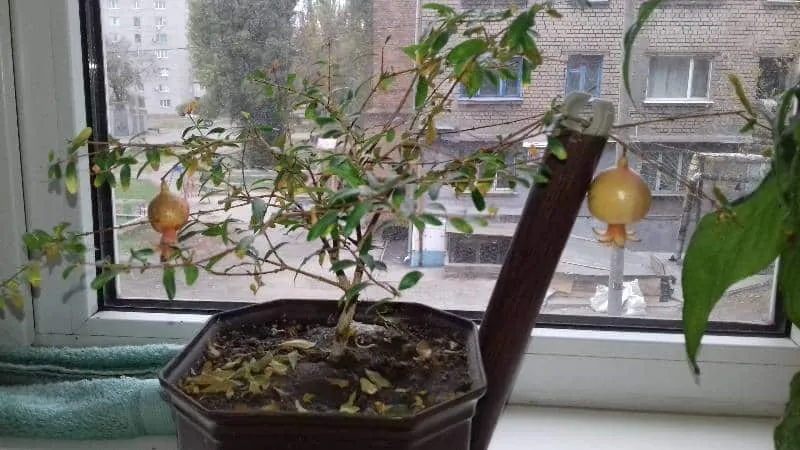
- Branch Canker – Cracks and swollen lesions. Early stage: Clean wounds, spray with copper sulfate, and seal with grafting wax. If severe, cut the tree down.
- Gray Mold – Treat soil with Trichoderma and spray TMTD fungicide.
- Root Canker – Repot, remove growths, and treat cuts with wax.
- Aphids – Spray with tobacco infusion (40 g tobacco in 1 L hot water, steep 2 days, dilute 1:2, add 4 g soap).
- Spider Mites, Whiteflies, Scale – Use garlic/onion spray (20 g peel in 1 L water, steep 5 days). For mites, apply NeemOil or Spinosad.
- Fruit Borer – Remove infested fruits.
- Mealybugs – Spray Mospilan or Provanto thrice, 5 days apart.
Conclusion
Dwarf pomegranates thrive indoors—grown from seeds, cuttings, or grafts. They fruit reliably, adapt easily, and offer diverse propagation methods.







